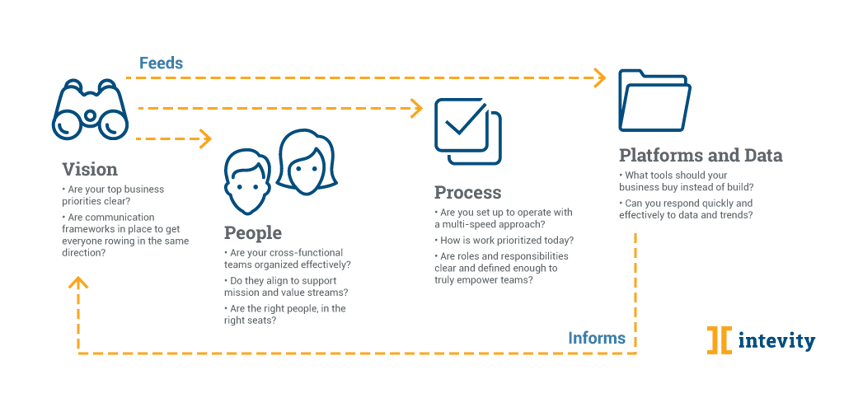3 Steps to Meaningful Digital Transformation
Technology has transformed today’s organizations. Workforces are remote, customers demand more (and they demand it faster), data is accessible across platforms and interfaces, and modern emerging technologies like artificial intelligence and cloud computing have replaced clunky, legacy technology systems. We now live in a digital world, but are you and your organization thriving or merely surviving?
The truth is, despite significant investment, organizations still can’t move fast enough. Teams struggle to collaborate. Systems are unable to adapt in order to meet changing demands. Business needs pile up and innovative opportunities fall through the cracks. In order to move quicker and make better decisions, organizations need to better adapt to the digital age. Enter: “digital transformation.”
But what is digital transformation? And why is it so hard to do? Ask 3 different people and you’ll get 3 different answers.
In its simplest form, digital transformation refers to using digital technology to create new and improve existing ways of doing business and serving customers. And, regardless of the industry, organizations are recognizing how the vital this is for their future.
As technology transforms the world around us, organizations must transform internally as well. Accelerating business activities, lowering operational costs, fast-tracking innovation, and increasing agility and responsiveness to customer needs are all essential to today’s (and tomorrow’s) digital organization. (We define a digital organization/digital business as an organization that has figured out how to use digital and technology to simplify their business — not overcomplicate it).
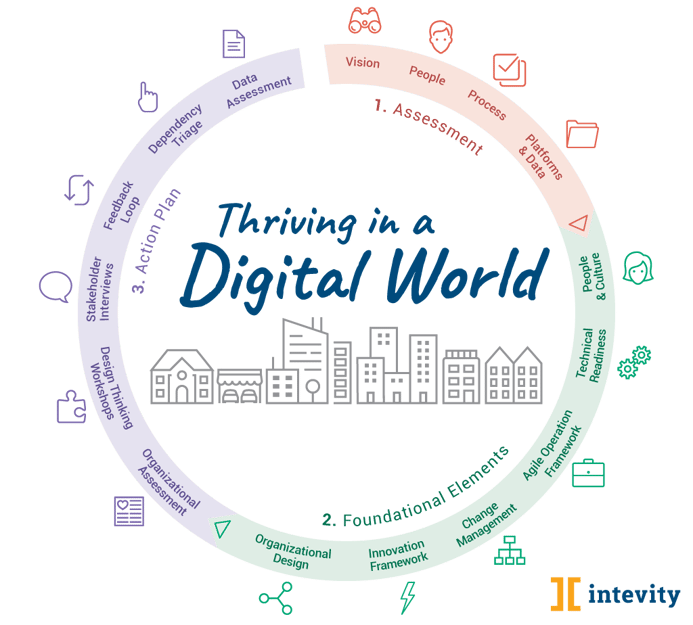
The challenge with digital transformation initiatives is knowing where to start and which levers to pull.
Reports show that more than half of current companies lack the internal structure and practices to compete with new and emerging digital organizations. Complaints we commonly hear are, “we aren’t moving fast enough” or “we don’t innovate well.”
Organization size doesn’t matter here. Everyone remembers when Blockbuster focused on building more stores while Netflix focused on making video rental more convenient. This highlights that even the largest companies with the biggest budgets struggle. All organizations face like a lack of shared vision or teams focusing on systems and features rather than solutions and outcomes.
To make meaningful and lasting change that enables you to thrive requires a holistic digital strategy.
Get started by asking yourself three core questions:
- Assess: Do you have a good understanding of the current state of your business and platforms?
- Foundational Elements of Transformation: What are the relationships and dependencies between the foundational elements of your digital ecosystem?
- Action Plan: What is your path forward and is it actionable, measurable, and fully aligned with your company’s overall vision and strategy?
Step 1: Assess
Digital transformation isn’t simple. It can become a drawn out, costly undertaking, which either doesn’t demonstrate value for years or ultimately fails to meet business goals. To decrease risk and increase speed-to-market, we recommend organizations take a holistic approach to transformations by first stepping back to assess the current state.
This assessment gives organizational leadership the data they need in order to have an overall understanding of the current state of the business. When done effectively, an assessment should go well beyond technology and platforms. We’ve found in our work across a number of Fortune 1000 companies that many variables influence the health and efficiency of an organization and its individual teams. But, these variables can all be distilled down into four (4) buckets: vision, people, process, and platforms (which includes data).
Take the time from the get-go to understand what enables success and what holds both the organization, and (often more telling) individual teams back. Call out organizational weaknesses or unnecessary complexities in your processes. Address the technical and human aspects of your business in order to transform those hurdles into strengths. These four (4) themes will give you the holistic understanding of the organization needed to start your transformation with eyes wide open.
Step 2: Foundational Elements of a Digital Organization
Now that you know where your strengths and weaknesses are, plan for change.
Successful and highly efficient digital organizations are able to orchestrate different changes throughout their business - in concert. Too often, businesses try to tackle one component (e.g. innovation frameworks) without acknowledging how other elements are impacted or how everything fits together. This is how symptoms get addressed but not the root cause. Dependencies that wreak havoc downstream are easily missed.
Operational velocity is achieved by applying foundational elements and frameworks, which allow teams to move more quickly and incrementally learn and improve. The key is to develop a roadmap that recognizes and manages dependencies across your organization without slowing down progress.
So how does your organization ensure it's keeping pace? How do you be one of the few lucky ones that succeed at digital transformation the first time around?
Here are six interconnected components to transform your organization into a more agile, cost-efficient, and technology-forward version of itself.
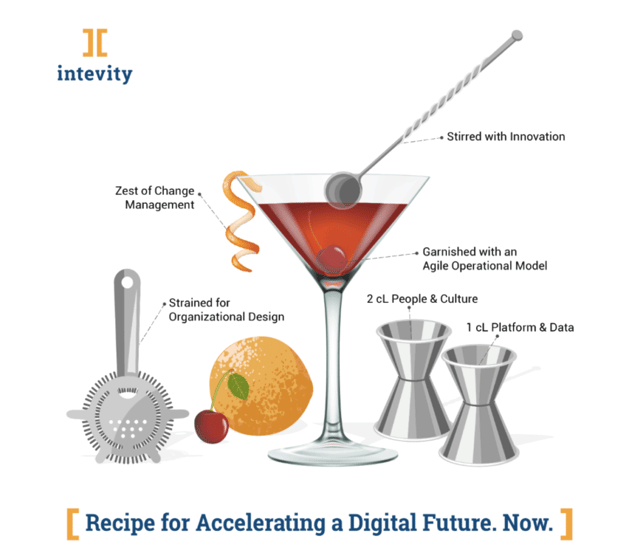
1. Organizational Design
Unless your organization is relatively young, it likely wasn’t designed with digital in mind. As technology brings new strategies and models to your business, your organizational structure and operating model will need an upgrade.
Siloed departments and complex hierarchical structures slowing the flow of information can no longer be considered good enough. Your organization needs to be redesigned for agility, multi-department collaboration, and the adoption of new roles. Modern organizations are adopting new roles such as Chief Digital Officer or VP of Digital and adding teams previously deemed unnecessary.
2. Agile Operational Model
Equipped with the design for a more efficient, digitally-capable organization, you will also need a matching operational model.
Goals should flow top-down and reach everyone within the organization in order to ensure holistic alignment and accountability. Lightweight prioritization and governance structures provide just enough direction to drive timely decision-making while not going too far to be considered stifling.
Key managers or team leaders need to be empowered to act with autonomy because every decision can’t take weeks and a committee to decide. Agility and speed in the face of evolving technologies are critical for survival and success.
Teams should be cross-functional to break down silos, drive well-round thinking, and organize to deliver solutions—not features.
An agile operational model provides extreme clarity in roles and responsibilities, which are paramount to responding effectively to a changing digital landscape.
3. Innovation Framework
Whether through a pace-layered model or an external incubator, your organization needs an innovation framework to enable long-term growth. Without it, your organization becomes stale and evolving consumer behaviors migrate your customers elsewhere.
As start-ups saturate and disrupt the market, traditional companies must continually look forward and enable the quick and consistent integration of new products and services. This means providing a safe space for experimentation outside of your traditional channels and platforms. This safe space protects your employees doing the innovation, failures will happen; and prevents disruption to your already established business pipeline.
4. Platforms and Data
With an increasing number of IOT and connected services, organizations are overloaded with data. The problem for most organizations is that they can’t actually access that data easily and have no idea what it should mean to them even if they could. Disparate legacy systems making data tedious to find and even harder to pull insights from is a top reason many organizations are held back from responding faster to customer and stakeholder demands.
Even when investments are made, many companies are not able to validate those investments because they lack the ability to use data as objective measures.
Organizations require overarching platform and data strategies that not only serve the present, but also plan for the future. Systems must communicate, services must be shared across departments, and data needs consideration at every step. This is so crucial to transforming businesses to being more digital and yet many overlook it when distracted by other new and shiny innovations. The problem is that almost all of these shiny innovations first need a solid platform foundation and data strategy to work.
Because of this, make strategizing and optimizing your platform and data infrastructure an immediate “must have” in your digital organization versus a “nice to have.”
5. People and Culture
If your technology platform is the foundation, then your people and culture are the cement binding everything together.
Digitally-forward organizations require new skill-sets (e.g. data science, user experience) and behaviors (e.g. agile, transparent), as well as a matching digital culture that will attract and support new talent and also the retraining of current employees. This is essential to forming the cohesive, collaborative, and high-performing cross-functional teams that advance organizational goals.
Investing in your people and culture to align with your transformation allows employees to respond smoothly to change, root out inefficiencies, and continually improve and drive accountability and action.
6. Change Management
“The Only Thing That Is Constant Is Change” -Heraclitus
Building a digital organization requires a multidisciplinary approach. Organizations must continuously learn, adapt, and implement new ideas at a rapid pace.
Changing initiatives that bring new technologies and processes can be viewed by employees as threatening, intimidating, or unnecessary. It’s not enough to tell two groups to work together and hope that that alone will break down any silos between them.
Aligning stakeholders and employees on a shared vision of the future will help frame your organizational transformation as more than just “digital.” Manage change deliberately, starting with true empathy and transparency, to de-risk internal changes and increases their ability to succeed from the start.
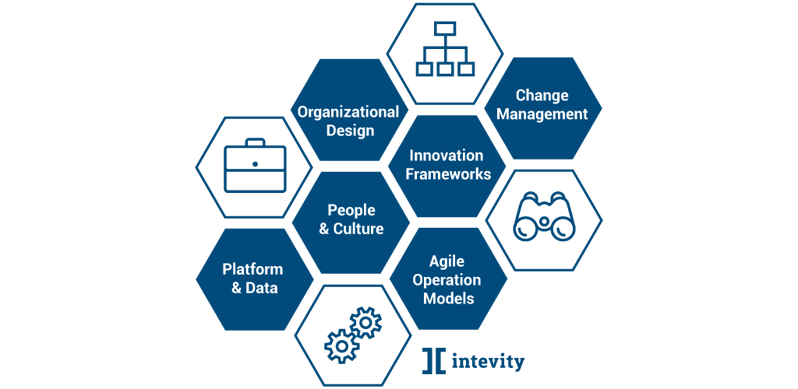
Step 3: Create an Action Plan
You’ve done the research and you’ve created a plan - now, apply it.
Be cautious about blindly implementing frameworks that have worked for others (e.g. Spotify Squads) without considering your organization’s unique business needs and culture. Your actions should be tailored to your organization. This may mean restructuring teams to better align to value streams, conducting a series of design thinking workshops to de-risk an idea or problem, or setting up an innovation accelerator. The key is putting a plan in place that is clear, measurable and aligned to the mission of the organization.
The DIY method - Transparency to Drive Change
In times of disruption, navigating change with confidence is crucial for leaders to increase revenue and capitalize on evolutionary or revolutionary opportunities. Too often, the necessary change agents are inadvertently hindered by bureaucracy.
In 2012, Eastman Kodak filed for bankruptcy. Many observers at the time believed it was due to the company’s failure to embrace emerging digital technology. However, Kodak was a pioneer at exploring, inventing, and investing in digital technology. What ultimately led to Kodak’s downfall was complacency and its inability to manage change in the face of market disruption.
The emerging question becomes: How can organizations make the transformative changes needed to address market chaos, in order to remain relevant to customers, and to beat out their competition? A traditional response to competitive pressures is, “We compete against external forces by building a better consumer product.” However, our experience has shown that the most significant threats are actually internal.
Executive leadership in organizations of all sizes and across the public and private sectors have different approaches to dealing with disruption. Ultimately, we have found that these upsetting forces are rooted in two primary challenges: the inability to empower change agents or the failure to identify (and solve) the right problem. The inability to conquer such internal challenges can cripple and even shutter a company.
The Stall (or the Frozen Middle)
What we have observed in many organizations is essentially a stall. A team or individual proposes an idea. The idea takes shape as a plan. The plan gathers energy and begins to take flight. The team is confident in the idea, but then meets resistance within the organization. The execution begins to stall, and the team loses momentum. Without a boost of speed and energy to right the effort, the plan collapses and the concept is never fully realized.
An alternative to the stall is the “frozen middle.” This refers to any management tier within an organization that is hesitant to move forward. Ideas get stuck and ultimately become frozen.
We are fascinated by the two groups typically behind successful change: the visionaries (top leaders) and the doers (those closest to the problem). Both groups may feel a sense of urgency and desire change but unfortunately, it is rare that these two groups are effectively aligned.
Lack of Movement = Risk to Relevance
Organizations today, self-actualized or not, are being forced to change. The longer a company ignores implementing a culture of change [i], the more at risk they are for being disrupted. A lack of movement means risking relevance with customers and target audience. How do you make change happen?
Workshops to Enable Transparency
One solution we’ve found successful to identify the right problem to solve and acknowledge a desire to change is by holding a workshop. This step enables management to align and craft an initial strategy. Once they agree to an overarching strategy, understanding the “how” of execution becomes the next step.
Because significant internal changes are not often easy, holding a cross-organizational, participatory workshops successfully teases out ideas, frames the problems, and then creates a set of metaphors and common visualizations. By the end of the assessment, leaders can say, "Alright. Now, I not only understand the problem, but I also see possible solutions."
When done correctly, your workshop will force people to say, “no,” to poorer-quality ideas. It's a targeted method that drives change because it requires people to say, “I recognize its value, but I'm choosing to say, ‘no’”.
Transparency compels people to take a stand. Rather than let ideas peter out, stakeholders must consider options and defend their decisions. This approach creates a culture that accelerates change by encouraging decisive action.
When No Leads to Yes
A common understanding and shared vision of a problem are critical to make change possible. There will be those who embrace the change, those who resist it, and others who remain unsure and unconvinced. Our experience shows that the “unsure” group is where the most people lie.
They tend to be more fearful, distracted, or unconvinced that change will be positive. By engaging this audience and making them confident in the success of change, you overcome a threat to non-transparent organization’s-silence.
The workshop-and-assessment process engages all participants by requiring them to speak to risk, apathy, poor morale, or other threats to change. It also brings out the voices of those who have the vision and desire to drive change forward.
When organizations attempt change without alignment, the catalysts often find themselves isolated and ultimately defeated. However, by uniting and collaborating, you can form consensus teams to work together in order to openly explore whether specific ideas are right for your organization.
Transparency allows a group of change agents to engage with the broader "unsure" group in order to inform decision-making on yes or no choices. Typically, the yes answers will increase. Once you get a substantial enough consensus, the idea will gain momentum, and your organization can explore and accelerate changes to help you thrive.
Not everyone can go alone—bring in a Guide
Most companies aren’t born digital and aren’t necessarily structured to thrive in today’s digital world. Managing change can be difficult. The best way to reduce risk and time-to-value on digital transformation is to engage a trusted digital guide. Guides will help you understand your customers, navigate the technologies, and move a solution through your organization.
As a digitally-focused management consultancy, we help brands return focus to where it matters most: their core business. Regardless of the focus of your challenge (program, product, data, platform, digital innovation), we recognize that organizations have real pain, need to move quick, and not overcommit.
[i] Change culture in this instance is not referring to change management, but to a cross-organizational culture that can identify and enable the right changes to happen as needed.
Accelerator Program
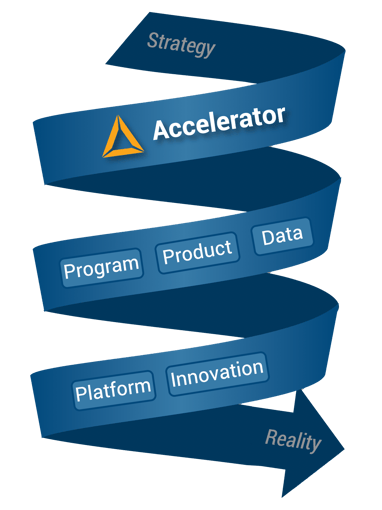
Our 6-week Accelerators are designed to act as an organizational change catalyst by validating the problem being solved is the right one and putting an action plan together to move from Strategy to Reality.
To make meaningful and lasting change, our cross-functional teams partner with key stakeholders to truly understand an organization’s business challenges, culture, and the way work gets done on a daily basis.
Joint working sessions, key stakeholder interviews, hands-on whiteboarding, and a vast network of subject matter experts are a few of the ways we are able to provide smart, specific, and meaningful insights fast.
Meaningful and lasting digital transformation is realized by organizations that understand and effectively manage the interplay between technology, the human experience, and organizational change. Through the lens of Digital Triality℠, we connect these problems by moving beyond the constraints of a singular perspective and clarifying the root causes of challenges.


